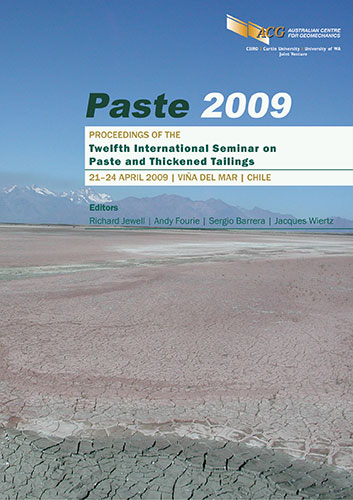Control and Management of Thickened Tailings Beach — A Simplified Approach

|
Authors: Luppnow, D; Moreno, J; Palape, M |
DOI https://doi.org/10.36487/ACG_repo/963_28
Cite As:
Luppnow, D, Moreno, J & Palape, M 2009, 'Control and Management of Thickened Tailings Beach — A Simplified Approach', in R Jewell, AB Fourie, S Barrera & J Wiertz (eds), Paste 2009: Proceedings of the Twelfth International Seminar on Paste and Thickened Tailings, Australian Centre for Geomechanics, Perth, pp. 245-250, https://doi.org/10.36487/ACG_repo/963_28
Abstract:
Prediction of the beach slope profile in thickened tailings disposal is currently being approached by methods based on empirical expressions or by undertaking pilot plant trials. In order to estimate the beach slope using empirical methods, it is generally necessary to know the flow rate of the slurry, its density, its solids content and the rheology of the slurry The rheology of the slurry is usually described using the Herschel-Bulkley model or Bingham plastic model. These models require a laboratory test programme to estimate the yield stress, viscosity and the Herschel- Bulkley indices. This process can be time consuming and expensive for high level engineering design, and for ongoing control and management of tailings beach. The Esperanza thickened tailings project included a pilot plant where several laboratory tests were developed for various solids content. The resulting data was used as an input for the beach slope estimation method based on non-Newtonian open channel flows. The results of the prediction indicated that there is a strong correlation between the yield stress and the beach slope. Considering the yield stress as an indicator of the beach slope, a method for control and management of beach slope is suggested. Prediction of the tailings beach has been significantly researched during the last years and there are few methods currently available from the literature. SRK has used a simplified method to predict and control tailings beach. Experiences with conventional operations in South Africa (platinum tailings spigotting) and TTD systems in Australia were combined and applied for the Esperanza tailings system design where disposal strategy consists in using multiple spigots to actively manage the beach to achieve the required slope.
References:
Fitton, T.G., Williams, M.P.A., Seddon, K.D., Bhattacharya, S.N. and Chryss, A.G. (2007) Simulation of thickened
tailings stacks, Proceedings of the Tenth International Seminar on Paste and Thickening Tailings, A.B. Fourie
and R.J. Jewell (eds), Australian Centre for Geomechanics, Perth, Australia, pp. 305–313.
Paterson, A. and Cooke, R. (2007) Thickened and paste tailings transportation course. November 2007. Santiago, Chile.
Pirouz, B. and Williams, M.P.A. (2007) Prediction of non-segregating thickened tailings beach slope – a new method,
Proceedings of the Tenth International Seminar on Paste and Thickening Tailings, A.B. Fourie and R.J. Jewell
(eds), Australian Centre for Geomechanics, Perth, Australia, pp. 315–327.
Pirouz, B., Kavianpour, M.B. and Williams, P. (2005) Thickened tailings beach deposition. Field observation and full-
scale flume testing, Proceedings of the Eighth International Seminar on Paste and Thickening Tailings,
R.J. Jewell and S. Barrera (eds), Australian Centre for Geomechanics, Perth, Australia, pp. 53–72.
Simms, P. (2007) On the relation between laboratory flume tests and depositions angles of high density tailings,
Proceedings of the Tenth International Seminar on Paste and Thickening Tailings, A.B. Fourie and R.J. Jewell
(eds), Australian Centre for Geomechanics, Perth, Australia, pp. 329–335.
250 Paste 2009, Viña del Mar, Chile
© Copyright 2025, Australian Centre for Geomechanics (ACG), The University of Western Australia. All rights reserved.
View copyright/legal information
Please direct any queries or error reports to repository-acg@uwa.edu.au
View copyright/legal information
Please direct any queries or error reports to repository-acg@uwa.edu.au